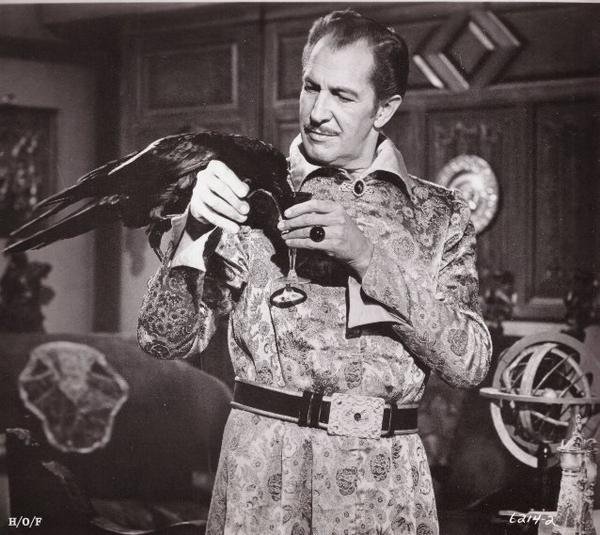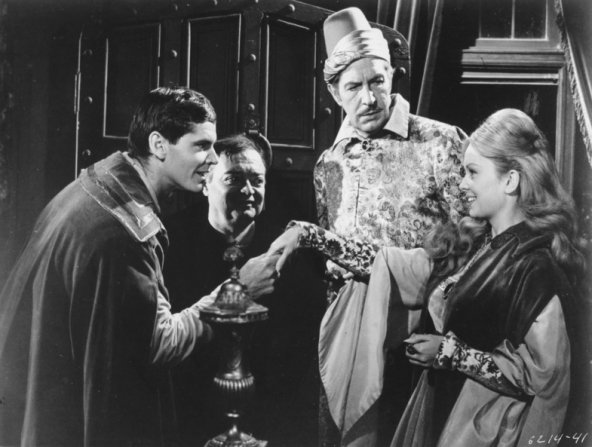THE RAVEN (1963): The Lighter Side Of Sorcery
After cranking out a few successful Poe-derived shockers, Roger Corman was smart enough to realize he needed to change up the formula a bit if he was going to mine this vein for further success. He followed classic horror genre thinking by adding a dash of humor for his adaptation of The Raven. This tactic can sometimes misfire but Corman managed to sidestep such pitfalls - and in the process, he cranked out the most purely entertaining film in the series. Richard Matheson's script takes a few elements from the Edgar Allen Poe poem - a talking raven, a deceased wife named Lenore - and uses them as the springboard for a fantasy adventure narrative. Erasmus Craven (Vincent Price) is the unwitting hero, a mild-mannered magician who is still mourning the passing of his wife Lenore (Hazel Court) when he is visited by a talking raven. Said raven claims to be a man transformed by a spell and when Craven reverses it, said raven turns into cranky fellow magician Bedlo (Peter Lorre).Bedlo asks Craven to help him get the revenge on the magician who transformed him, a legendary magician known as Scarabus (Boris Karloff). Craven is reluctant to do so until Bedlo swears that he saw a woman who looks just like Lenore at the castle of Scarabus. In short order, Craven and Bedlo are off to
Richard Matheson's script takes a few elements from the Edgar Allen Poe poem - a talking raven, a deceased wife named Lenore - and uses them as the springboard for a fantasy adventure narrative. Erasmus Craven (Vincent Price) is the unwitting hero, a mild-mannered magician who is still mourning the passing of his wife Lenore (Hazel Court) when he is visited by a talking raven. Said raven claims to be a man transformed by a spell and when Craven reverses it, said raven turns into cranky fellow magician Bedlo (Peter Lorre).Bedlo asks Craven to help him get the revenge on the magician who transformed him, a legendary magician known as Scarabus (Boris Karloff). Craven is reluctant to do so until Bedlo swears that he saw a woman who looks just like Lenore at the castle of Scarabus. In short order, Craven and Bedlo are off to  that castle with Craven's daughter Estelle (Olive Burgess) and Bedlo's son Rexford (Jack Nicholson!) in tow. Scarabus seems to be friendly at first but he's got a few surprises up his sleeve, starting a chain of events that climaxes in a memorable magician battle.Over fifty years later, The Raven remains a charmer. The comic approach is more natural than it might seem at first: Corman is simply combining the stately gothic style he developed on his earlier Poe adaptations with the quirky, deadpan style of humor he developed on films like Little Shop Of Horrors. Matheson's adventure approach lends itself to this light treatment and boasts a clever array of twists in its final half-hour that enhance its entertainment value.
that castle with Craven's daughter Estelle (Olive Burgess) and Bedlo's son Rexford (Jack Nicholson!) in tow. Scarabus seems to be friendly at first but he's got a few surprises up his sleeve, starting a chain of events that climaxes in a memorable magician battle.Over fifty years later, The Raven remains a charmer. The comic approach is more natural than it might seem at first: Corman is simply combining the stately gothic style he developed on his earlier Poe adaptations with the quirky, deadpan style of humor he developed on films like Little Shop Of Horrors. Matheson's adventure approach lends itself to this light treatment and boasts a clever array of twists in its final half-hour that enhance its entertainment value. It helps that Corman had assembled a rock-steady technical crew that creates a plush backdrop for the tongue-in-cheek adventures: Daniel Haller supplies typically elegant production design, Floyd Crosby's photography maintains the gothic tone while Les Baxter's jaunty score substitutes cartoon-music style antics and quotes from classical sources in place of the usual blood-and-thunder theatrics. With their help, Corman achieves one of his best sequences as a director with the final magical duel, which showcases some surprisingly good visual effects for the era as it balances Tex Avery-style visual gags with kinetic excitement.How
It helps that Corman had assembled a rock-steady technical crew that creates a plush backdrop for the tongue-in-cheek adventures: Daniel Haller supplies typically elegant production design, Floyd Crosby's photography maintains the gothic tone while Les Baxter's jaunty score substitutes cartoon-music style antics and quotes from classical sources in place of the usual blood-and-thunder theatrics. With their help, Corman achieves one of his best sequences as a director with the final magical duel, which showcases some surprisingly good visual effects for the era as it balances Tex Avery-style visual gags with kinetic excitement.How ever, the biggest fun in The Raven comes from the antics of its triumvirate of classic horror stars. Price has fun playing against type as a more milquetoast, less theatrical version of his tormented Poe-film heroes while Karloff deadpans through his villainous role with a playful glint in his eye, adding a few extra fun shadings to the role when his character is revealed to have an all-too-human Achille's heel.That said, it's Lorre who walks away with the movie as a scheming, perpetually irritable magician whose ego outreaches his abilities. If you want to think of the movie in spaghetti western terms, he's the "Ugly" to Price's "Good" and Karloff's "Bad" - and the glee he shows in chewing scenery and adlibbing is positively contagious.In short, The Raven is the crowd-pleaser of Corman's Poe cycle, a good-natured comic adventure that prompts smiles instead of chills. You don't have to be into Poe's gothic horrors to enjoy this romp.
ever, the biggest fun in The Raven comes from the antics of its triumvirate of classic horror stars. Price has fun playing against type as a more milquetoast, less theatrical version of his tormented Poe-film heroes while Karloff deadpans through his villainous role with a playful glint in his eye, adding a few extra fun shadings to the role when his character is revealed to have an all-too-human Achille's heel.That said, it's Lorre who walks away with the movie as a scheming, perpetually irritable magician whose ego outreaches his abilities. If you want to think of the movie in spaghetti western terms, he's the "Ugly" to Price's "Good" and Karloff's "Bad" - and the glee he shows in chewing scenery and adlibbing is positively contagious.In short, The Raven is the crowd-pleaser of Corman's Poe cycle, a good-natured comic adventure that prompts smiles instead of chills. You don't have to be into Poe's gothic horrors to enjoy this romp.


